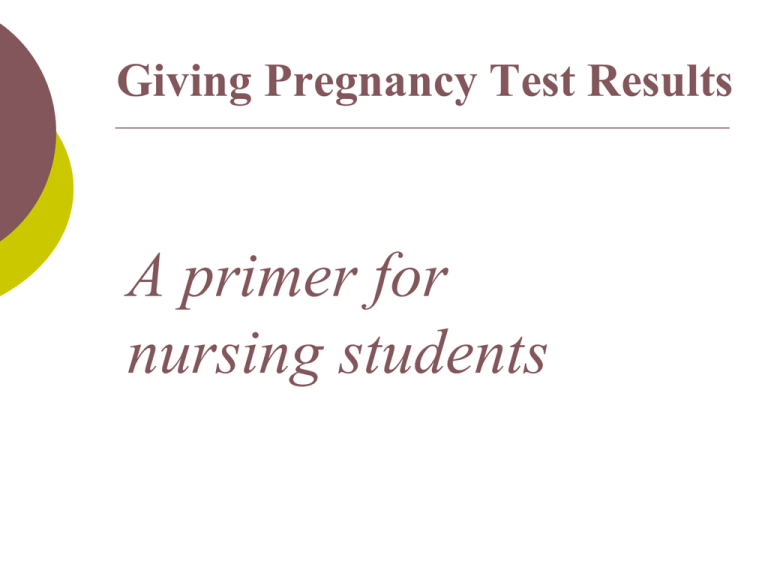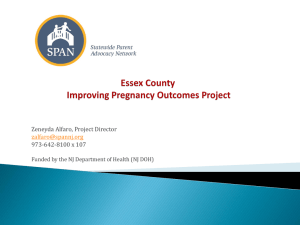
Giving Pregnancy Test Results
A primer for
nursing students
Overview of presentation
Principles
of giving pregnancy test
results
Identification of immediate health
concerns
Overview of laboratory pregnancy
tests
Ideally, the nurse has the opportunity to interact
with a client prior to giving test results:
Why
does she think she may be
pregnant?
When was her LMP?
How is she feeling about the
possibility of pregnancy?
If meeting the client for the first time
Introduce yourself and describe your
professional position before giving the
test results.
Eg. Hi, I am Sarah, a nurse here at
the clinic.
Giving results
Give the results at the beginning of the
client encounter.
Eg. Hi, I am Sarah, a nurse here at the
clinic and I have the results of your
pregnancy test. The test is positive. You
are pregnant. Pause.
Be clear and to the point in giving results
Some women may be confused by the “test is
positive”. They may be so anxious that they
do not understand or are confused by the
terminology. By stating “you are pregnant” ,
the nurse leaves no doubt.
Eg. Hi, I am Sarah, a nurse here at the clinic
and I have the results of your pregnancy test.
The test is positive. You are pregnant. Pause.
Give the client a moment of silence
A woman may need a few moments to process the
information and collect her thoughts.
Give her time to reflect back to you how she feels
about the result.
Pay attention to non-verbal clues.
Focus on the client's reactions and feelings: "How
are you feeling about this?" or "Is this what you
were expecting?" or "You seem
upset/sad/shocked/happy" etc...
If the test result is negative:
If the women is disappointed, assess
further. If there is a concern of
infertility, make appropriate referrals.
If the woman is relieved, this is a
“teachable moment” for contraceptive
counseling.
“Teachable Moment”
Contraceptive Counseling
Discuss effective contraception and develop a
plan with her for accessing safe
contraceptives.
Educate her about “behind-the-counter”
emergency contraception (Plan B) or if a
teen, provide a prescription in advance along
with safer sex counseling.
If test result is positive:
If the woman is pleased with the positive
pregnancy results, congratulate and discuss
early pregnancy care.
Many women will experience ambivalence
over the positive test results so it is important
for the nurse to discuss options of adoption,
abortion and of continuing the pregnancy.
Ambivalence
If the woman is experiencing
ambivalence, assist her in identifying
life circumstances that will affect her
decision to parent or not parent a child
at this time in her life.
Help the woman identify her
support systems
Most women will want to involve a partner,
friend or family member in their decision.
Generally health care issues are considered
confidential but some states require parental
notification or parental consent for a teenager to
make a decision about the pregnancy. In the case
of abortion, many states with such
notification/consent laws have judicial bypass
arrangements for teen who cannot/will not
involve their parents.
Time frame
Reassure her that she need not make the
decision today. She can take some time to
think through what is best for her.
Arrange subsequent visits or an appointment
with a counselor.
Ask women what additional information or
support they want.
Facilitate referrals and follow-up care,
if needed:
To provide referrals in a seamless manner, the
nurse needs to know local referral resources.
Have pamphlets and brochures available for:
adoption agencies
abortion services
prenatal care providers
counseling services
(if not provided in your setting)
If continuing the pregnancy:
Provide a prescription for prenatal vitamins.
Provide education about the effects of
alcohol, drug use, smoking, toxins and certain
medications on a developing pregnancy.
Screen for any personal or family history of
genetic diseases that may require a consult
with a genetic specialist.
Elicit any immediate concerns
Does the woman have any immediate social
concerns?
Screen for domestic violence.
Does the woman need nursing support or
medical management for nausea of pregnancy?
Screen for abdominal/pelvic pain with vaginal
bleeding. If present, refer the woman for an
immediate workup for a possible ectopic
pregnancy.
Professional responsibilities
Engaging in self reflection and values
clarification about the intersection of personal
beliefs and professional responsibilities.
Uphold the woman's autonomy and right to
care.
The ANA Code of Ethics offers an ethical
framework for approaching nursing care.
If giving pregnancy test results, it is
important to understand the type of
pregnancy test
Overview
of laboratory pregnancy
tests
Monoclonal
testing:
Urine
Serum
antibody pregnancy
Monoclonal antibody pregnancy testing: Urine
Detects
human chorionic
gonadotropin (HCG) in urine.
Highly sensitive, Can detect as little
as 20-50mIU/mL in urine.
Qualitative measure (“yes” or “no”)
Quick, simple, low-cost
Over the counter (OTC) versions
available
Monoclonal antibody pregnancy testing:
Serum
Highly
sensitive >99%
Can detect as little as 10mIU/mL in
serum
Qualitative measure (positive or
negative)
Quantitative-Used primarily for
clinical management of pregnancies
that are problematic or concerning.
Serum quantitative hCG Levels
<1 week =
2 week
3 week
4 week
5 week
6-8 week
12 week
5-50 mIU/mL
50-500
100-10,000
1,000-30,000
3,500-115,000
12,000-270,000
15,000-220,000
Additional Resources
Check www.roeresources.org for
additional resources including the ppts:
Caring for the Woman with an Unintended
Pregnancy: Abortion as an Option and
Options Counseling for Unintended
Pregnancy
For a hard copy of our referral resource,
contact info@provideaccess.org
PPT updated 2.17.14









